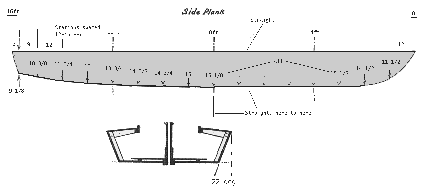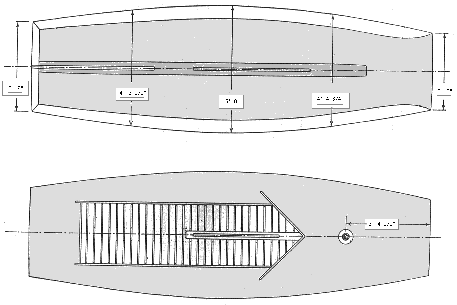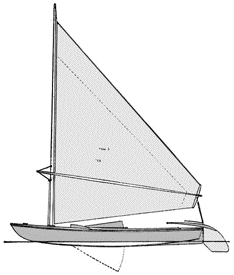This slightly refined
garvey, of approximately 16 feet overall length, has a beam of 3
feet at the bows, 5 feet at midsection and 3 feet 6 inches at the
transom. The draft is approximately 4 inches.
Her sides are 16 inches from deck to bottom and they
flare 6 inches, which gives her a bottom of 4 feet 6 inches breadth at
the midsection.
[NOTE... this seems to be a typo.
The drawings are marked with 22 degrees flare, or six inches per
side, giving a midsection beam at the floor of 4 feet. If the flare
is only 3 inches per side, the angle must be approximately 11 degrees.
There's nothing wrong with less flare, as long as you adjust what is
shown in the drawings. The boat with less flare will have more
stability. Perhaps I can resolve this with a model. A difference in
flare will affect sheer and rocker but not the panel shapes shown
below].
Flare of 11 degrees = 4' 6" bottom width at
midsection
Flare of 22 degrees, as drawn = 4' at midsection
Although the old garvies carried the conventional
gaff cat rig, I prefer the sprit leg-o'-mutton sail once used on the
Mosquito and Cricket boats of Atlantic City [dating from 1895-1900].
No stays or shrouds are used with such a rig and the
butt of the mast is soaped or greased so it will turn and allow the
sail to pull the sprit to leeward. The forward end of the sprit is
supported by an outhaul which leads to a cleat at the after end of the
centerboard trunk, permitting adjustment of the draft of the sail at
any time.
The design was worked out by rule-of-thumb, and on
the front porch another boat bug and I built her of cypress and copper
fastenings. Click here for larger
image.

The sides were cut out of two 16-inch-wide planks
and these bent around three forms to fix the angle of flare, their ends
brought into place and held there by a temporary transom at the stern
and battens at the bow. By nailing a stiff pine plank on top of the
forms and end supports, we maintained the centerline. Click here for larger image.

Side and bottom planking is 13/16 inch thick.
Permanent frames or battens were beveled and fashioned out of 1-1/4 by
1 inch screen stock and fastened a foot apart to the side planks. After
fastening the deck carlines and notching in the partner planks, the two
of us picked her up by the ends and turned her over to plank the bottom.
We planked the bottom athwartship and, instead of
caulked seams, used the Japanese method, grooving each plank with a
brass screw-eye turned in a small block of wood. We fastened a 13/16 by
5 inch keel inside and a sand-shoe of similar dimensions outside.
Building a board well to fit one of the centerboards
on hand, we fitted a shallow skeg and stern post to the stern to
support the secondhand rudder, taking care that the skeg would not
increase her draft. The hull was thoroughly saturated with kerosene
before painting, to prevent undue swelling of the cypress and to keep
the wood from waterlogging. We used 11/16 inch groove-and-tenon ceiling
for the decking and covered the same with 16 ounce duck, laid in thick
paint.
She took very little water and, as we were anxious
to learn how her centers balanced, we stepped the mast, hoisted sail
and were off! She carried just the right amount of helm in the gentle
breeze and we patted ourselves on the back and admitted that we were
good! We were so tickled with the job that we hardly noticed how
quickly she had crossed the bayou. She seemed to have speed.
Although her sail was setting abominably, when we
close hauled her she pointed higher than we expected and seemed to foot
well to windward. We began to suspect that a garvey was something more
than we had anticipated. Although she was steady, she handled smartly.
Not yet satisfied, we raised the centerboard in the
well and I'm a stone crab if the funny looking little packet didn't
work to windward with a draft of less than four inches !
![]() ...to
Plywood Boats or to The
Cheap Page or to The
Odd Sails or Short
Boats
...to
Plywood Boats or to The
Cheap Page or to The
Odd Sails or Short
Boats